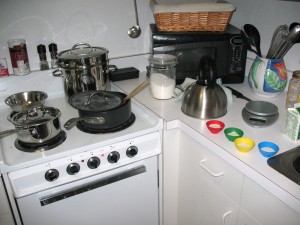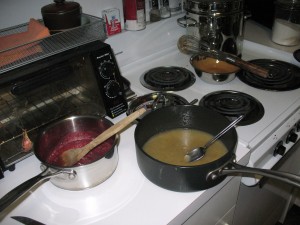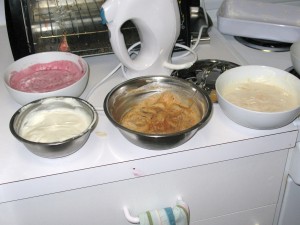Experimenting with mousses
April 5, 2010
Part of what interests me about cooking is its chemistry. Many foods - especially baked goods and confections, it seems - rely on complex and specific chemical reactions for even their most basic properties.
Take whipped cream, for example. Whipping something doesn’t always make it airy; you can whip water or chicken stock and it won’t become a foam. But there is something about the chemical structure of cream, and eggs, that allows them to retain air bubbles for a period of time.
One of the first “serious” dishes I ever made was a chocolate mousse, which is an interesting way of turning chocolate into a foam. This particular recipe uses unflavored gelatin and whipped cream, but my understanding is that traditionally you would use whipped egg whites and yolks.
I started thinking, what else could I make into a mousse? So I decided to try some experiments. The first step in each was coming up with a liquid with the same approximate consistency as melted chocolate. In retrospect this may not have been necessary. Once that was done, I subsituted each liquid into the chocolate mousse recipe I linked above, adding a little or less gelatin as seemed to be necessary.
I made four mousses.
Raspberry. This was probably the best of the four. I used a sauce of raspberries and sugar. Next time I do this, I will probably filter out the raspberry pieces that were left in the sauce, though I don’t think this caused a particular problem. This went very well with the polenta cake I made at the same time, about which more in the next entry or so.
Grapefruit. Again, I made a sauce of grapefruit juice and sugar, and some grapefruit pieces. I thought the grapefruit might cause the whipped cream to curdle, but it didn’t. This was a little strange, but not terrible; if you can imagine grapefruit pieces and cream, that is what it tasted like. I wonder if a peach or strawberry mousse might work well.
Peanut butter. I was able to simply melt the peanut butter to achieve the consistency I wanted. This actually came out pretty well, and was delicious on Ritz crackers.
Cheese. Yes, cheese mousse. I used melted whipped cream cheese for the base. This basically became a spreadable cheese, but was by no means bad. It would be a great way to build a custom cheese spread, incorporating herbs and other flavors into something that can be put on crackers easily.
Overall, the experiment was really interesting and gave me a new side to make for various desserts and perhaps other dishes. I think the next 3 mousses to try are strawberry, peach, and kiwi. They’ll go really well with a cheesecake or other savory cake. It would be interesting to try some of these with the traditional mousse recipe as well; I’m not sure if they would work.



